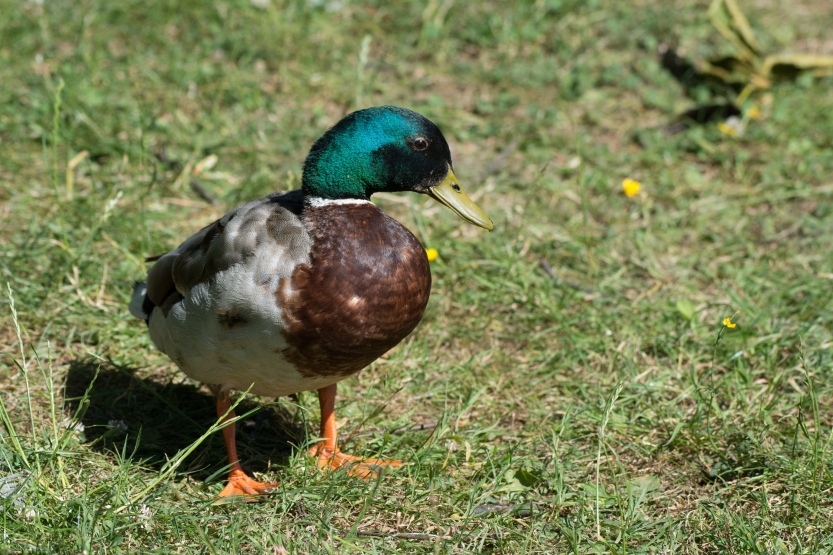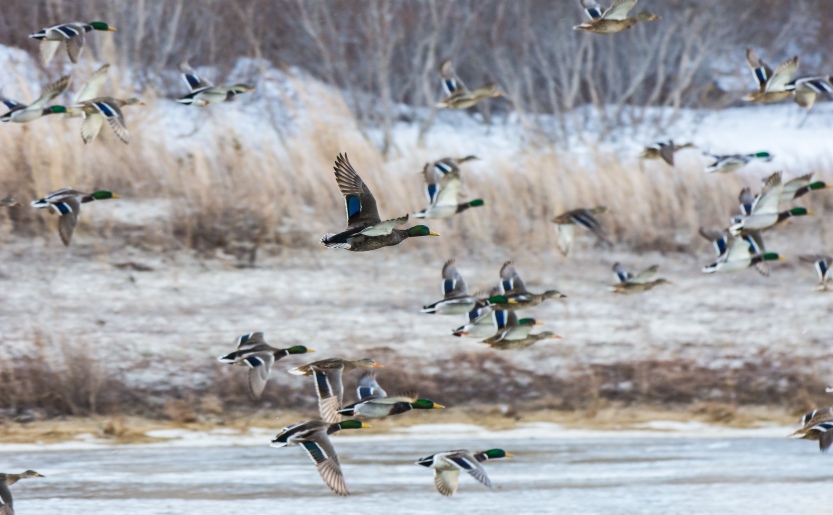Why Mallards? A common duck that can be seen in vast numbers all over the world. It isn’t difficult to photograph. It shows up in just about any body of water, and fearlessly dabbles around people. Hardly worth an article, is it?
The English meadow was picture perfect in the warm June sunshine. Shades of green with polkadot daisies, shadow islands cast by ancient oak trees. My young son and I were feeding a very large flock of Mallards. My dad, now in his 80s, wandered towards us from Weald Country Park visitor center with another bag of duck feed. I figured that he had bought the feed for my son, who was now sat in the middle of a swarm of greedy quacking ducks. But no; he proceeded to feed his own mob of Mallards. So there we were, three generations of nature lovers, feeding a flock of marauding Mallards. We were talking to them, making sure each got its fair share, admonishing the bullies and laughing at their antics. This is what makes the humble Mallard such a memorable nature encounter for so many.

I can’t remember a time when I wasn’t encountering Mallards. I have very early memories of wanting to go to the pond to feed them. Half the family would go off to do whatever they wanted to do, while someone took me, the youngest, to the duck pond. They had no choice, as I had begged them until I broke them!


The male Mallard is a spectacular sight. If a parrot were dressed in such finery we would surely bestow the highest praise upon them. The hood is a blaze of metallic green laced with blues, the bib is chestnut while the boots are high-visibility orange. These are the colours worn by the male. He has no real work to do, other than to look pretty. The female has a nest to sit on and young to raise. She is dressed more conservatively, to melt into the grass and leaves

Back over the Atlantic ocean, my local Mallards nested on an old pier in the Hudson River. The proud mum brought her seven little ducklings to the beach at an old boat dock. A mature bird can lay over a dozen eggs, but my local hen was proud of her little brood. I watched the hen protecting her flock for the first couple of days. She kept them close and scooped them all underneath her when they slept.

After a couple of days the ducklings became a little more adventurous and the hen was happy to let them stray a little further in their search for food. As well as the usual diet of seeds and aquatic plants, I have watched ducklings in something close to a frenzy when there are flies on the water. They will whirl around like an over-wound bath toy snapping up the meaty morsels for a little extra protein. A duckling has to grow up fast and that means the race is on to pack away as much nutrition as possible.

Back in the UK, I made a summer visit to the Royal Horticultural Society property, Hyde Hall Gardens in Essex. A family of ducks had made their home on the ornamental fish pond. I stood watching the hen and her ducklings dabbling in between the water lilies. It was a hot day and a sprinkler was watering plants on the edge of the pond. As I stood watching, the mother duck hopped out of the pond followed by her brood, and one by one they walked past me, stepping on my feet as they trotted over for a cooling shower in the sprinkler.

Like all good mums, the hen kept an eye on her flock as they pecked and pulled at new shoots, and insects. One even found a worm that was devoured with the speed and discretion of a kid knowing that a sibling would be looking for half!


Mallards from the far north of their range are migratory. Faced with the prospect of a brutal Alaskan winter they head south. Some travel as far as Central or South America. I encountered a huge flock of migratory birds at Cape May, New Jersey. It was first light on a snow sprinkled morning as I walked to the lake. I stepped out from between some trees when an explosion of Mallards, startled by my presence, burst into the air. I lifted the camera and pressed the shutter release as they disappeared into the air. With the wrong lens and no light, I was quite pleased to capture a small slice of the flock.


My morning commute takes me along the Hudson River. There is a small ‘beach’ outside my apartment. A Mallard with unusual colouration arrived there to spend the molting season. I thought nothing of it, assuming that it was a domestic cross, but the more I looked at it the more I became intrigued. I did a little research and discovered that the duck was a natural Apricot colour morph.

A little more reading revealed that almost all domestic ducks originate from the mallard, and it is the selective breeding with colour morphs such as apricot and white that has introduced such variation into the domestic breeds.

I’ve been so fortunate to travel the world and experience some of the most iconic wildlife on the planet. But I named this blog Incidental Naturalist because there is so much wildlife to be encountered in everyday life. There are few better examples of this than the Mallard. A bird that sees me off on my daily commute, is there whenever I visit a park, greets me when I fly home to visit my family, and has seen me on each of the four continents that I’ve lived on.
Go on; buy yourself a bag of duck feed and head to the park today and spend a little time with these beautiful birds.
Join the conversation below. Did you feed the ducks as a kid? Maybe you take your kids to feed them now? Maybe you still feed them? Are their Mallards in your country? 👇👇👇
** Like the article? Share give it a Tweet or post it on Facebook. If you enjoyed this post, please take a look at the rest of my work and consider following Incidental Naturalist. If you don’t have a WordPress account you can follow via email. I’m not going to try to sell you anything and there will be no spam **
Categories: United Kingdom, USA





I mostly see other ducks around but that perhaps may be because I live on the ocean and it’s different ducks that prefer the ocean. They ARE super cute and fun to watch though.
LikeLiked by 1 person
Yes, mallards hang around river estuaries but not so much the ocean. Nothing much cuter than a duckling 🐥
LikeLiked by 1 person
I agree. Super fluffy and cute. And I like their beaks.
LikeLiked by 1 person
Loved reading this David!
LikeLiked by 1 person
Excellent! Glad you enjoyed it, Yakov. Hope you are well.
LikeLike
I love your blogs about all the common animals around us. People tend to pay attention to the hard to get things instead of enjoying all the beauty within reach. Walking with my dog makes it a bit hard to approach any living creature and take photographs of them since he is in the frontline to sniff it all. Thank you for doing the work for me! 😆
LikeLiked by 2 people
Thanks for stopping by and leaving a comment. Very kind. It is always nice to know that people appreciate the local stuff as well as the exotic. Keep that sniffy dog under control! 😀
LikeLiked by 1 person
Very interesting read about a common yet so unknown bird. As you write, we are often surrounded by more wildlife that we at first believe. Even the most concrete-laden cities have sometimes surprising occurrences of wildlife, like birds of pray. As every naturalist knows, life always finds a way.
LikeLiked by 1 person
Thanks for stopping by and taking the time to leave a comment. I admire any wildlife that can make a home in our cities. birds or prey are a great example. Alsmost all the peregrine falcons that I have seen have been in our concrete jungles. I hope to photograph them some day.
LikeLiked by 1 person
Wonderful, David “) Love your comment that there’s wildlife we encounter in everyday life We can appreciate and learn from it daily.; need that reminder and that connection. – Great photos, all, but especially love the birds in flight, the ducklings tucked under their mother, and the close up of that Apricot Mallard with beak tucked.
LikeLiked by 1 person
Thanks Lara! I’m glad that you like the photos. They are pretty photogenic! The ducks in flight photo was a miracle as they exploded up into the air so fast and unexpectedly. It was a lucky shot! The Apricot mallard had an Apricot duckling this year 😊
LikeLiked by 1 person
=) I’ve never heard of an Apricot Mallard before – nor seen, I think. Beautiful! Love the learning you provide, David. It fosters an even deeper appreciation for our natural world. Looking forward to the next post!
LikeLiked by 1 person
Such wonderful photographs! Especially the second last, and the flock in light, and the single ducklings approaching. Beautiful. I too love mallards and have photos of them from around the world. And my local urban wildlife includes racoons, beaver, squirrels, great blue herons, swans, eagles, and more. We are so blessed.
Alison
LikeLiked by 1 person
Wow Alison, that is some fantastic urban wildlife!! 😊 Thanks for the kind comment. It is hard not to point the camera at the charming little dabblers, isn’t it?
LikeLiked by 1 person
Great photos. I used to love feeding the ducks after school and still do, although it’s mostly swans on the river where I live.
LikeLiked by 1 person
Thank you! 🙏 ducks are the best for kids. I was always a bit nervous of the swans and geese. But ducks are just a fantastic way for kids and adults to be with nature.
LikeLike
Cool, I like it.
LikeLiked by 1 person
Great post! I love mallards! If they weren’t so common, people would be seeking them out to catch a glimpse of their iridescent beauty. There is so much beauty to be found in the common wildlife that surrounds us!
LikeLiked by 1 person
Mallards are our constant companions on our little pond. In cold weather I may sprinkle corn chops out for up to 35-40 males and females… I have a very tender heart towards these “common” little dabbling ducks.
LikeLiked by 1 person
That is wonderful! It is impossible not to have a tender heart towards these tough little dabblers.
LikeLike